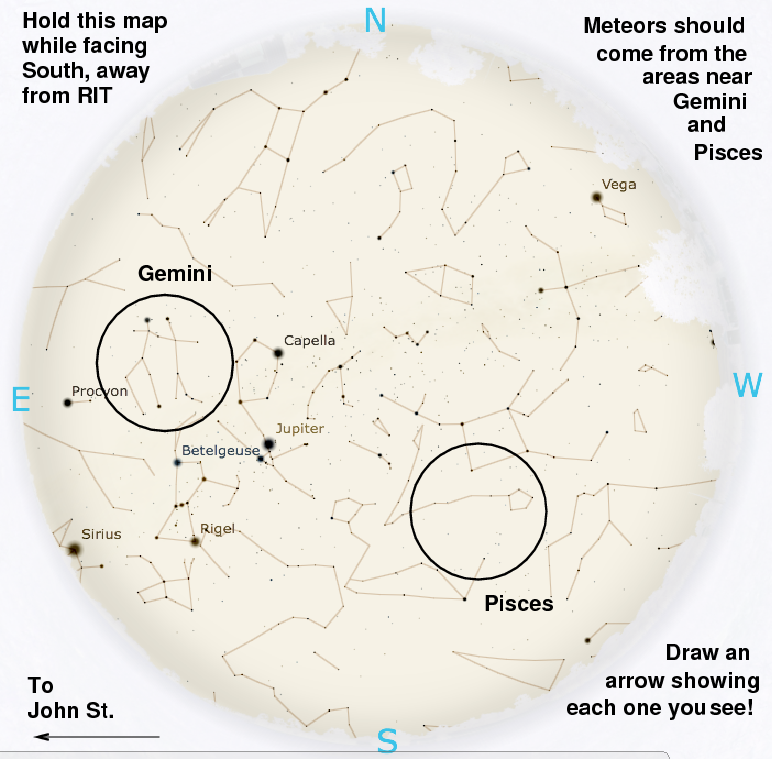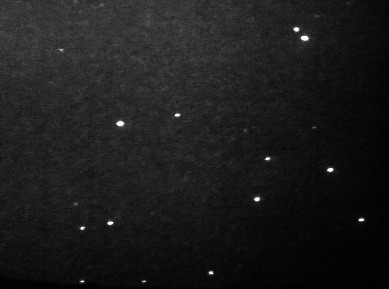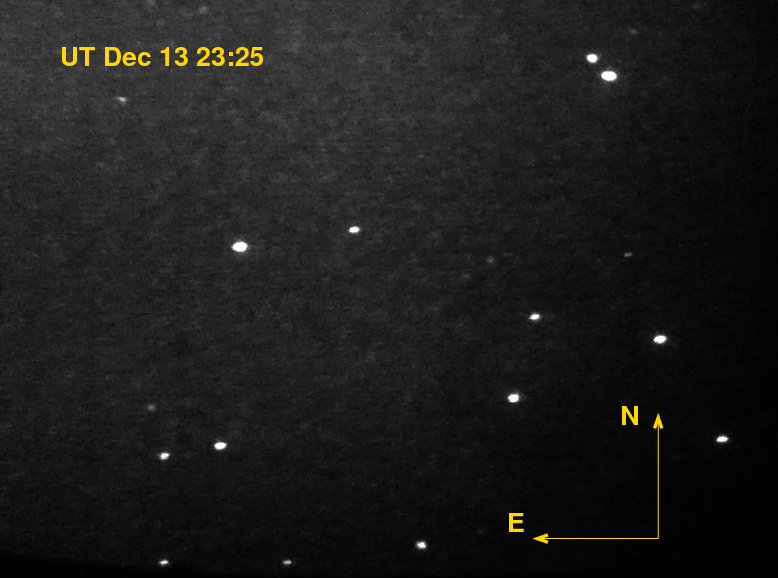
Our Open House on Dec 13, 2012, was a success! About sixty visitors came to watch the skies with us. See notes on the evening below.
Our main features tonight will be Jupiter and its moons, and the Geminid meteor shower.
Jupiter will be rising in the East as the sky grows dark. Look for the brightest object in the sky -- that will be Jupiter! Tonight, you may see four of the moons which orbit this giant planet. One of them, Europa, will be passing in front of the planet's cloudtops from 7:30 to 8:30 PM, moving from left-to-right in the picture below. As it moves, it will uncover the Great Red Spot.

Tonight is a good time to the Geminid meteor shower, which has its peak around Dec 12-14 each year. On these dates, the Earth moves in its orbit through a region of space filled with debris from an old, worn out comet. As the Earth zips through this region, it slams into tiny grains of dust -- BAM! -- like a car's windshield smacking into insects. The grains enter the Earth's atmosphere moving tens of thousands of miles per hour, causing them to heat up and radiate light as they disintegrate.
The map on the other side of this paper shows the location of the constellation Gemini. Meteors will appear to shoot outward from this general region of the sky, so concentrate on looking in that direction. You might see 5 to 10 meteors per hour.
But there may be a bonus! A recent scientific study by Russian astronomer Mikhail Maslov suggests that the Earth may run through another trail of dust particles tonight, left behind by Comet Wirtanen. These meteors will come from the region of the sky we call Pisces, which will be to the southwest in the early evening. The forecast is very uncertain, but we may see 2 to 4 meteors per hour from this region.

About sixty visitors came to look at Jupiter and the meteors with us. It was cold, but we were dressed warmly and had coffee and hot chocolate to warm us up. The event ran from about 7 PM until about 9:15 PM, when the increasingly thick clouds put a damper on things.
Most of the meteors we saw were from the Geminid radiant. I didn't get any real quantitative measure of the rate, but based on the frequency of "oohs!" and "aahs!", I'd estimate that we saw about 15 to 20 meteors per hour. Given the bright skies so close to campus and the commercial district of West Henrietta, and the relatively low position of Gemini in the sky, that's not bad.
In addition to Jupiter and the meteors, we were able to see asteroid (4179) Toutatis using our integrating Orion Starshoot video camera mounted on the 12-inch telescope's guidescope. The asteroid was about tenth magnitude as it zipped through the sky, at a distance of only 0.048 AU (about 7 million km). Because it was so close, it moved very quickly relative to the stars: over one thousand arcseconds per hour!
Can you find the asteroid? Compare one image from our video camera (on the left) to a star chart (on the right). The bright star at middle left is HD 14244 = HIP 10747, North is up, East to the left, and the field of view is about 70 x 55 arcminutes.


Did you see it? To check your guess, look at the animation below. Toutatis moved quite a distance in the 15 minutes between each frame -- roughly 5 arcminutes.

Click on the image to restart animation
Visitors were able to detect the motion easily when I placed a small piece of tape next to the asteroid on the monitor; after just 2 or 3 minutes, it had moved away from the tape.
Want to learn more about Toutatis?